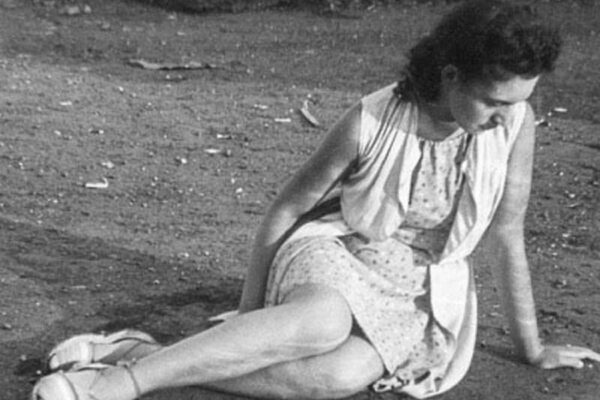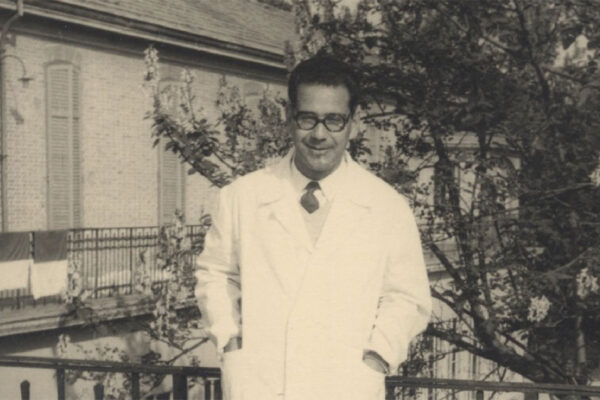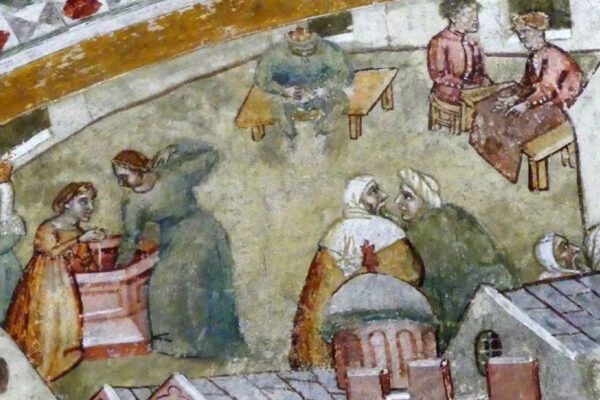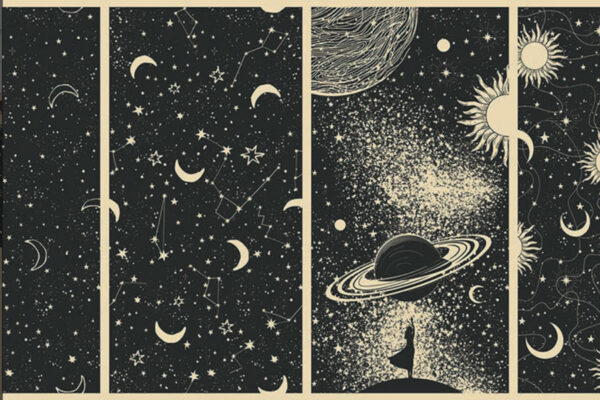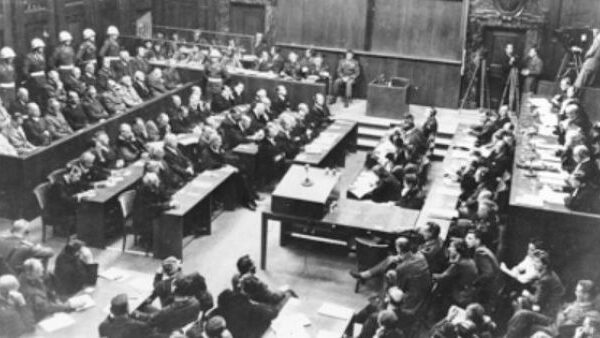Why Was the Libyan Holocaust Taken Out of Primo Levi’s Influential Book in Israel?
Prof. Claudia Rosenzweig’s well-worn Hebrew copy of Primo Levi’s “If This is a Man” – which was originally titled “Is This a Man?” in Hebrew – is full of notation marks. Every page features her handwritten notes in Italian.
A few years ago, she sat with two copies of the book and compared them. One was in her mother tongue of Italian, which was also the language Levi wrote in. The other was the Hebrew translation, which was published in 1988. On every page she highlighted a word in Hebrew with an arrow to the margin, where she wrote the original Italian word. It might have been for her own personal amusement, an endeavor for literary scholars, were it not for the small scandal that erupted about the translated Hebrew text a few years ago.
As is the way with literary scandals, it seems that few outside the industry were unduly concerned by it. Or even aware of it. After all, this scandal uncovered something in an old Hebrew translation of an Italian book that was published in 1947.
But things were a little more complicated than that. For starters, this was no mere book but one of the most important texts of the 20th century. Secondly, this was not merely about di!erences in style or a minor omission.
In 2020, Nitsa Nasrin Tuchman, then a doctoral student at Ramat Gan’s Bar-Ilan University, pointed to odd omissions in the Hebrew text compared with the original. At the start of the book, for instance, Levi describes a terrible event: On February 21, 1944, he and other Jews were in the Fossoli transit camp, near Modena, when they were told all 650 of them would be leaving by train the next day (on the train, they learned they were being transported to Auschwitz).
Levi captured the camp’s mood at this terrible news by focusing, like in some horrific close-up, on hut 6A. Here, he wrote, “old Gattegno lived with his wife, many sons, grandchildren, and industrious daughters-in-law. On their many wanderings, they had always kept their tools, harmonica, violin and kitchen utensils. They were used to playing and dancing after work, because they had both faith and good cheer. Their wives were the first to finish preparing the bundles for their journey. They worked quickly and quietly, so there would be time to mourn. When everything was ready, the bread baked and the bundles packed, they rescued their shoes, braided their hair, placed the memorial candles on the ground, lit them in the tradition of their fathers and sat down to lament.”
This was how generations of Hebrew speakers read Levi’s text, which had been translated by Itzhak Garti and published by Am Oved Publishing House in 1988.
But four years ago, Tuchman pointed out that the original paragraph had been written slightly differently (this is from the English version translated by Stuart Woolf): “In hut 6A old Gattegno lived with his wife and numerous children and grandchildren and his sons- and daughters- in-law. All the men were carpenters; they had come from Tripoli after many long journeys, and had always carried with them the tools of their trade, their kitchen utensils and their accordions and violins to play and dance to after the day’s work.
“They were happy and pious folk. Their women were the first to silently and rapidly finish the preparations for the journey in order to have time for mourning. When all was ready, the food cooked, the bundles tied together, they unloosened their hair, took o! their shoes, placed the Yahrzeit candles on the ground and lit them according to the customs of their fathers, and sat on the bare soil in a circle for the lamentations, praying and weeping all the night.”
This is also the version that appears in a new Hebrew translation, which is now called “If This is a Man” based on the poem Levi starts his book with: “Consider if this is a man / Who works in the mud / Who does not know peace / Who fights for a scrap of bread / Who dies because of a yes or a no.”
The new Hebrew version was translated by Meron Rapoport, edited by Prof. Menakhem Perry and published by Hasifriya Hahadasha.
As Rosenzweig remarks, the Hebrew title “Is this a Man?” not only elevates the text but also somewhat flattens it. It can be read only as a question, whereas “If This is a Man” is an invitation to reflect: if this is a man, what is man?
The omission of the Libyan Jews from the original translation caused a belated uproar primarily because it had taken decades for the Libyan Holocaust – which was mentioned so matter-of-factly by Levi in one of the first texts ever written on the subject – to be established in the Israeli consciousness and collective memory.
However, the new translation shows that this was not just one isolated, peculiar omission.
“The truth is that things of this magnitude appear in every paragraph,” says Perry. “The CEO of Am Oved wrote us a harshly worded letter following our statement about a flawed translation, so I ran a test: I went over 13 lines and there were 25 inaccuracies. Multiply that by the number of lines in the book and that means at least 4,700 omissions and inaccuracies.”
“Garti omitted a lot,” says literature scholar and editor Navit Barel, the granddaughter of a survivor of the Giado (aka Jadu) concentration camp in Libya. “Translators make mistakes and I don’t know if he deliberately omitted it or was distracted, but that doesn’t matter,” she says. “The important thing is that this book took decades to be translated into Hebrew, and when it was finally translated, there is no mention of the Holocaust in Libya – even though it was in the original.
“The night before they all left for Auschwitz was a significant evening – one in which everyone says farewell to life in the way that best suits them. Even before he describes the Gattegno family, [Levi] says the men were dealing in all kinds of ways with the knowledge that were going to die. Some of them ‘lustfully intoxicated for the last time.’ Some got drunk. Some prayed,” Barel says.
“But the mothers took care of the children and worked all night. They prepared food for the journey, washed the children, hung out the babies’ diapers on the barbed-wire fence and remembered every little thing. That is what leads him in his memory to Gattegno’s hut, which is described with all the family – a family of carpenters, children, grandchildren, sons-in-law, brides. Their journey was longer: they had already been far from home for a long time. And they had taken all their belongings with them even before that. The Gattegno family carried the symbols of their identity, their carpentry tools and musical instruments.
“The Tripolinian women were the first to finish the preparations, and why?” she continues. “Because they went to mourn. When the work was completed, the food ready, the bundles tied – only then did they cut their hair, tear their clothes, light the candles and begin to weep. The Italians stood before the hut door – and it’s a beautiful metaphor in a book that doesn’t have many metaphors. Levi writes: ‘We experienced within ourselves a grief that was new to us, the ancient grief of the people that has no land.’
“This paragraph does not just refer to the Holocaust of the Libyan Jews, but also to their Zionism. The connection that was not severed with this burden and the belief that they’re out to kill us. That’s what’s important. How could the most important book about Auschwitz not mention this? For both me and the story, it’s an important paragraph.”
Rosenzweig, a professor of Yiddish literature at Bar-Ilan University’s Department of Literature of the Jewish People, explains that “the previous version was translated and supposedly improved by the translator. However, when I gathered together all these changes, I realized that the Primo Levi text published in Hebrew is different to the one Primo Levi intended. His book is written in a clean way, it’s unsentimental and without manipulation. It’s writing that inspires understanding, thought. Writing that is not Jewish but universal, Italian.
“I compared the Italian with the previous translation and, in my opinion, anyone who read the previous translation did not read the real book – and not because of the outdated language. Primo Levi did everything to guide the reader: it was important for him that he be understood. He did everything he could so his text would be clear and leave no doubt. That it wouldn’t be interpreted differently from what he meant.
“I think Garti wanted to add things here and there, alter things that weren’t necessary, in my eyes,” Rosenzweig adds. “The book’s Hebrew title is also problematic because it’s not a question. Levi writes: ‘Consider if this is a man.’ It’s not a direct question but an inquiry the reader is meant to mull over, think about. It’s an invitation to reflect.”
Compassion and humanity
The lacuna between the two texts inspired Perry and his sta! at Hasifriya Hahadasha to publish the new Hebrew translation. Perry is also responsible for a new chapter in the book examining translations and the liberties some translators take – historically more so than today – with expansive interpretations based on their own style and inclination. In the case of Primo Levi, because of the clarity of his writing and the tragic circumstances of his life and death, the debate over his book and the issue in general is a particularly fascinating one.
In his conclusion, Perry offers an extraordinary reading of a writer blessed with an incredible capacity for attention to detail, yet also an equal measure of compassion and humanity. Levi’s impressions are clear, meticulous and unsentimental. He sometimes focuses on a person, situation, routine or even item of clothing. Conversely, he sometimes o!ers a description as if trying to forcibly evade the memory – like a painter rushing to wash their brush in a cup of water.
“If This is a Man” was Levi’s first book, a testimony from an Auschwitz survivor who turned out to be a great writer.
It was written shortly after his liberation from the camp and completed in January 1947. Despite the short time between his 11-month incarceration at the camp and the start of writing (he later said he began the book at Auschwitz, but destroyed every note and scribble out of fear that it would cost him his life if discovered), this is a measured composition where every word is perfectly calibrated.
Even though it took an age before Levi would become internationally recognized, and even though his career fluctuated and comprised works in various styles, his first book seems to have everything that marked him out as a great writer.
Perry’s lengthy and fascinating epilogue demonstrates how the mystery surrounding Levi’s death – biographers and scholars are to this day still arguing over whether he committed suicide or stumbled to his death in 1987 – is related to and influenced by his writing. But we will return to this matter later.
Levi was born in Turin in July 1919 and graduated cum laude in chemistry at the city’s university in 1941. He was a quiet, unassuming and short man whose features, as the photos show, were soft and gentle. Two years later, when the Nazis occupied northern Italy, he escaped and joined the partisans. His group was captured shortly afterward, when he was age 24. They were sent to the Fossoli transit camp for Jews and on February 22, 1944, all 650 Jewish prisoners were sent to Auschwitz.
“If This is a Man” describes Levi’s life from the moment he and his comrades were captured, the terrible five-day journey to Nazi-occupied Poland by cattle car and his 11 months in Auschwitz, until its liberation by Soviet troops on January 27, 1945. He returned to Turin in October 1945. He began to write his story two months later, and the first chapter he penned is the book’s last one: “The Story of Ten Days.”
He credited his survival to moments of happenstance: first, a prisoner he knew smuggled a little food to him. Then, a while later, the Nazis discovered he was a chemist by training and so assigned him to a camp lab, where the conditions were better. When the Nazis abandoned Auschwitz in January 1945, he was sick and so was left behind, thus avoiding the death march. Quite random survival – befitting for the Nazi dehumanization machine whose inner workings he captures in his book.
Levi had a hard time getting his manuscript published, though. The writer Natalia Ginzburg, the sister of his good friend Alberto Levi (no relation), worked at the Einaudi publishing house. She was the person who informed him that the publisher had rejected his manuscript on the grounds that there were already numerous books about the concentration camps. The book was ultimately published by Turin’s tiny De Silva Press: 2,500 copies were printed, but only 1,400 were sold (one is now in Jerusalem’s National Library of Israel).
A new edition was published a decade later, this time by Einaudi. Levi added a new chapter, “Initiation,” which concludes with a conversation between him and another prisoner, Steinlauf – a Hungarian from Milan – who tells him about the importance of always maintaining cleanliness. This, the prisoner tells him, is the way to “save at least the skeleton, the scaffolding, the form of civilization.”
This discussion inspired Levi to observe the methods by which prisoners strive to preserve their humanity, and he spent the rest of the time observing the methods and tactics employed for preserving the human spirit. Years later, he would tell American author Philip Roth that his life in Auschwitz became one of constant vigilance, committing to memory everything he saw.
Even the second edition only aroused moderate interest. Perry describes how Levi’s literary career somewhat stalled after this, until the release of his most successful book, 1975’s short-story collection “The Periodic Table.”
Perry also notes how Levi’s first book would eventually become the source of much of his activity. By the ’60s, “If This is a Man” had become mandatory reading on the Holocaust. Levi gave lectures on the subject and corresponded daily with readers around the world. Surprisingly, more years passed before his works were finally available in Hebrew.
In 1979, a Hebrew edition of “The Truce” was released by Am Oved. Hasifriya Hahadasha published a Hebrew edition of “The Periodic Table” in 1987, and a year later “If This is a Man” (with the “Is This a Man?” title) was finally published in Hebrew. But Levi, who had visited Israel in the ’60s and met with publishers, trying in vain to persuade them to publish his book, died in 1987 and did not live to see the Hebrew version.
Internal conflict
Since Levi died on April 11, 1987, the cause of his death has been much discussed by literary and cultural scholars, relatives and fans. Opinion is split. His family and many others believe he leapt to his death from the stairwell on the third floor of the building where he was born, a drop of about 15 meters (nearly 50 feet). Others argue that this was impossible, that he probably slipped and fell to his death, perhaps due to some weakness caused by low blood pressure.
This long-running debate still provides much fodder for articles, research papers and biographies. Perry’s essay “Levi versus Levi” addresses the question at length. Levi suffered six bouts of severe depression during his lifetime, some before Auschwitz – with the most serious coming six months before his death. He always insisted that his depression had nothing to do with Auschwitz and that, if anything, the months he spent there turned out to be a source of great personal growth, a colorful experience that made him the man he was. In his conversation with Roth, Levi explained that the concentration camp, and the fact he wrote about it, was an important adventure that changed him profoundly and gave him a reason to live.
Auschwitz also transformed him from a shy man who never started a conversation and never made a deep connection with a woman, to a man who couldn’t stop talking about the concentration camp. Even on the train that brought him back to Turin, he was talking to anyone who would listen.
In his essay, Perry speculates that this was why, in a fleeting act of madness – out of a longing to physically experience the metaphors of flight and floating that he frequently wrote about – Levi ended his life. He was someone living with a profound internal conflict, says the editor. A survivor who felt he was benefiting from a horrendous experience that so many others did not survive; who enjoyed writing and aimed to bring readers pleasure, yet never stopped wondering if in doing so he was betraying his moral duty.
“It wasn’t the memories of Auschwitz that led to his suicide, but his feeling that he had betrayed them and exploited them,” Perry argues. “Everything was perceived as Levi’s ‘victory’ over Auschwitz, but he felt he had placed this thick, impenetrable layer around his memories that concealed them. He wrote endlessly about flying, about longing to fly. It wasn’t rational. He didn’t leave his home with the intention of committing suicide, but it can’t have been an accident either. “He writes in one of his essays that everyone has a double inside them who opposes them. He created material that turned suffering and sadness into pleasure and enjoyment – like writing about horrible memories he enjoys. He wrote a story about a Soviet commissar whose memories destroy the paint his factory produces. He also wrote about colors and his success as a chemist in making colors, comparing his success in this to his success in writing his book, but two pages before explains that colors are fake. This is the writer he was.”
“If This is a Man” translator Rapoport concurs. “Everything that he wrote was somehow through the prism of Auschwitz. Levi had an extraordinary ability to maintain total scientific and human precision, and he had a totally dfferent perspective on the Holocaust than what we were taught in the Israeli school system. He is the polar opposite of Ka-Tzetnik,” he says, referring to the Auschwitz survivor who wrote trashy pulp fiction inspired by his time in the camp.
“Levi didn’t think the Holocaust was a separate planet. It’s here, human beings did it, it’s part of humanity and Auschwitz is part of humanity,” Rapoport adds. “We need to ask ourselves how human beings reached that point and what happens when human beings get to there. Also, Levi chose to write about the Holocaust without showing death. There is hardly any death in Primo Levi’s writing. There are hardly any corpses. This is a study about what a place like Auschwitz does to humanity, and he asks this question in such close proximity to the event with such clarity and distance and empathy. That really astonishes me.”
You were hired to correct the first Hebrew translation. What did you think happened there?
“I don’t understand the omission of the Tripolinian family, and I wasn’t aware of it before. This may be Primo Levi’s most Zionist paragraph, and he wasn’t a particularly Zionistic person. He didn’t grow up in a Jewish environment. The shared Jewish fate was revealed to him at Auschwitz. But I think Garti did something important by being the first to translate it [into Hebrew]. Levi wanted it to come out in Hebrew – he was here in the ’60s and tried to convince various publishers to translate it. Garti did this work. But in any case, just as there are different versions of songs, there can be different versions of one of the great literary works of the 20th century and more than one variation.”
The publisher, Am Oved, said in response to this story: “At this time, we are choosing to channel our energy and resources into expanding the publishing house’s illustrious literary legacy, not being dragged into divisive scenarios.”



